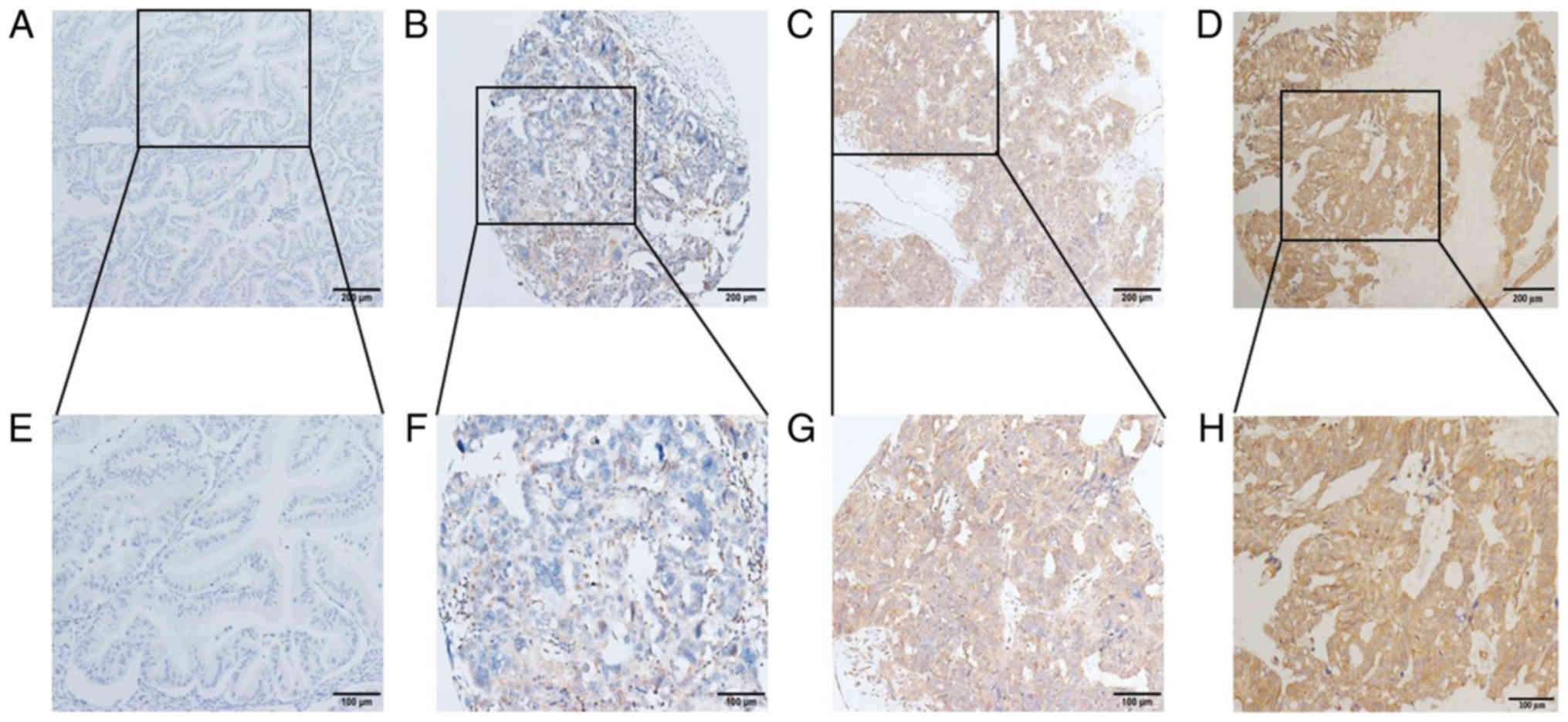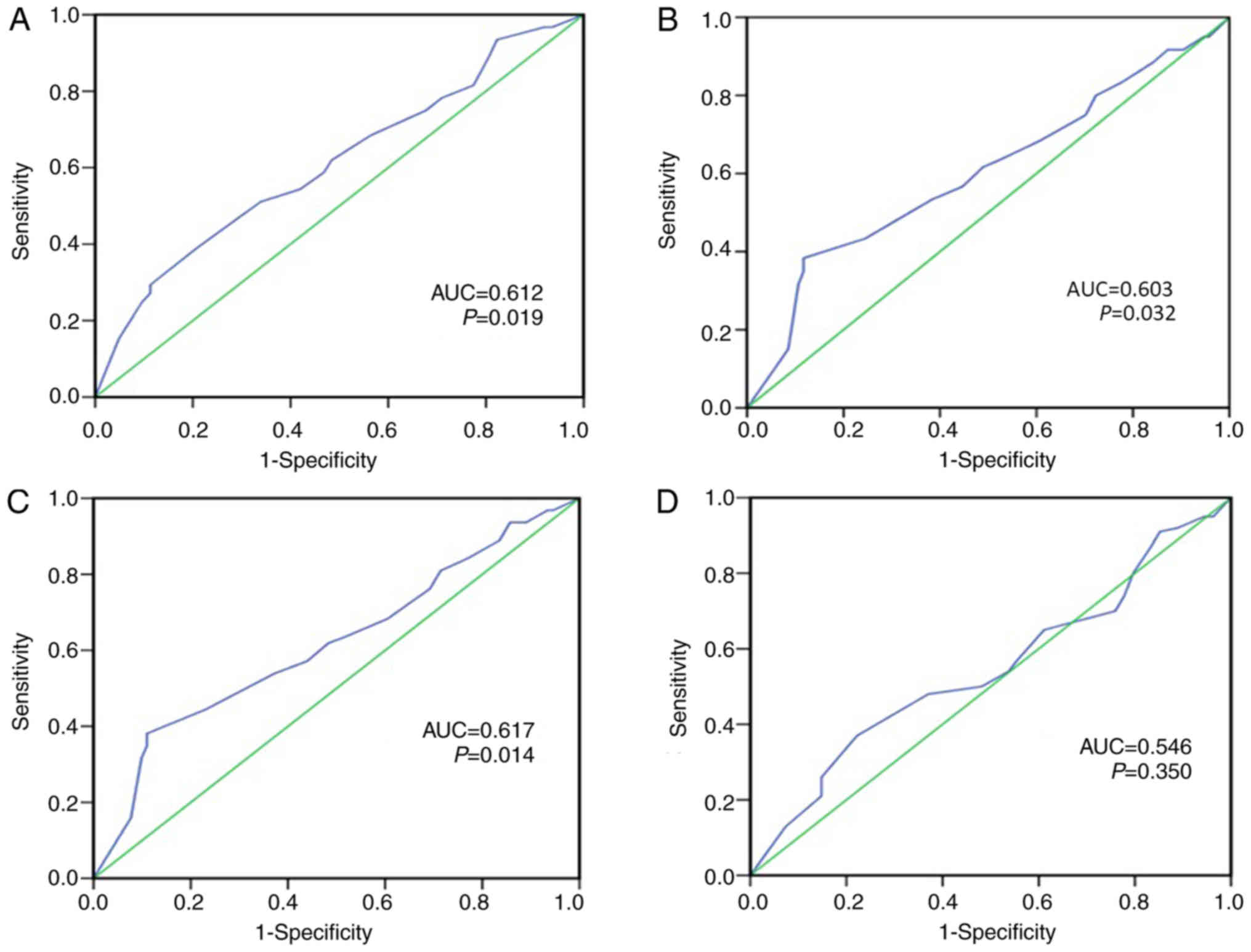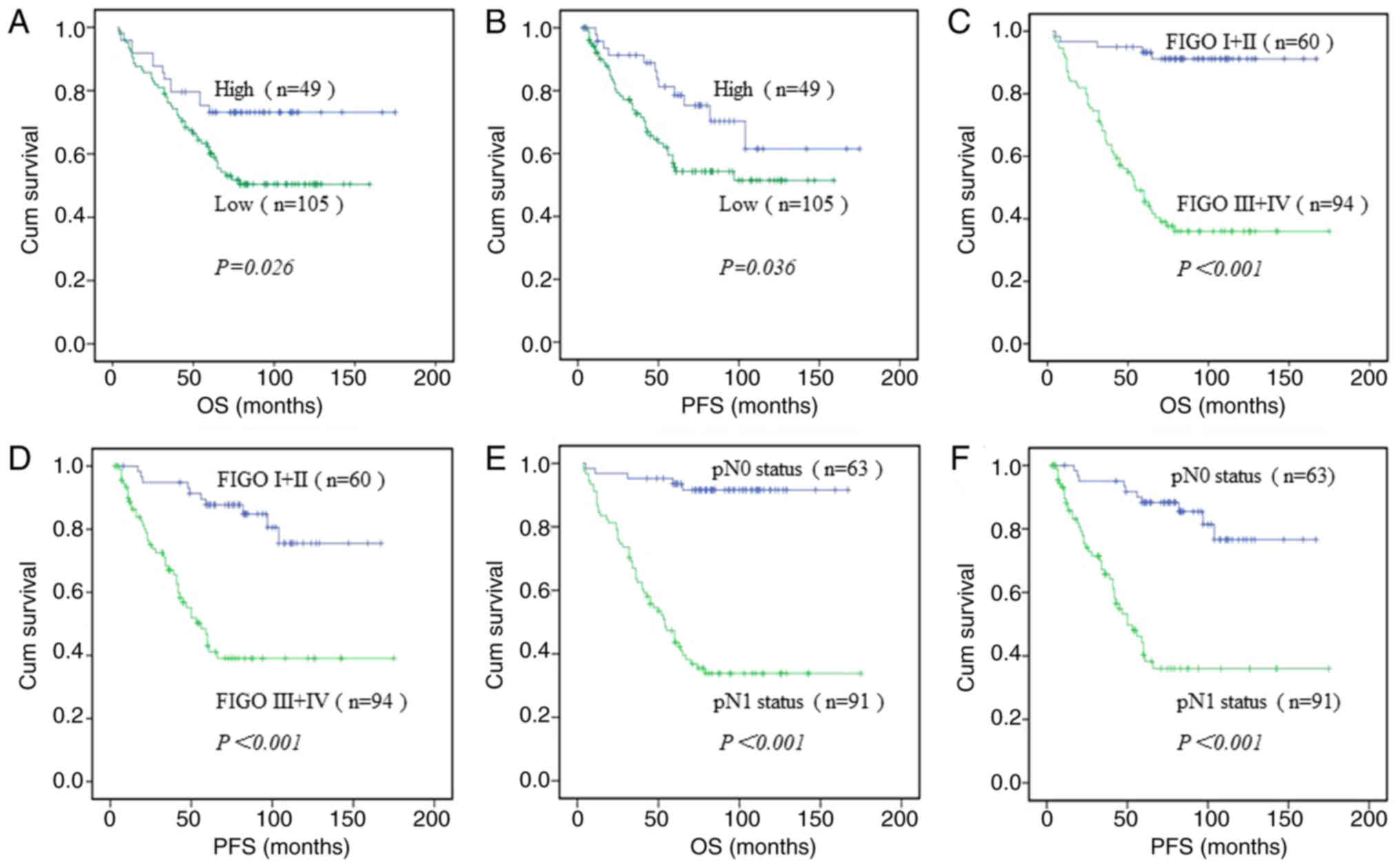|
1
|
Siegel RL, Miller KD and Jemal A: Cancer
statistics, 2018. CA Cancer J Clin. 68:7–30. 2018. View Article : Google Scholar : PubMed/NCBI
|
|
2
|
Torre LA, Trabert B, DeSantis CE, Miller
KD, Samimi G, Runowicz CD, Gaudet MM, Jemal A and Siegel RL:
Ovarian cancer statistics, 2018. CA Cancer J Clin. 68:284–296.
2018. View Article : Google Scholar : PubMed/NCBI
|
|
3
|
Rojas V, Hirshfield KM, Ganesan S and
Rodriguez-Rodriguez L: Molecular characterization of epithelial
ovarian cancer: Implications for diagnosis and treatment. Int J Mol
Sci. 17(pii): E21132016. View Article : Google Scholar : PubMed/NCBI
|
|
4
|
McCluggage WG: Morphological subtypes of
ovarian carcinoma: A review with emphasis on new developments and
pathogenesis. Pathology. 43:420–432. 2011. View Article : Google Scholar : PubMed/NCBI
|
|
5
|
Cancer Genome Atlas Research Network, .
Integrated genomic analyses of ovarian carcinoma. Nature.
474:609–615. 2011. View Article : Google Scholar : PubMed/NCBI
|
|
6
|
Kossaï M, Leary A, Scoazec JY and Genestie
C: Ovarian cancer: a heterogeneous disease. Pathobiology. 85:41–49.
2018. View Article : Google Scholar : PubMed/NCBI
|
|
7
|
Morgan RJ Jr, Armstrong DK, Alvarez RD,
Bakkum-Gamez JN, Behbakht K, Chen LM, Copeland L, Crispens MA,
DeRosa M, Dorigo O, et al: Ovarian cancer, version 1.2016, NCCN
clinical practice guidelines in oncology. J Natl Compr Canc Netw.
14:1134–1163. 2016. View Article : Google Scholar : PubMed/NCBI
|
|
8
|
Sant M, Allemani C, Santaquilani M, Knijn
A, Marchesi F and Capocaccia R; EUROCARE Working Group, :
EUROCARE-4. Survival of cancer patients diagnosed in 1995–1999.
Results and commentary. Eur J Cancer. 45:931–991. 2009. View Article : Google Scholar : PubMed/NCBI
|
|
9
|
Sant M, Chirlaque Lopez MD, Agresti R,
Sánchez Pérez MJ, Holleczek B, Bielska-Lasota M, Dimitrova N, Innos
K, Katalinic A, Langseth H, et al: Survival of women with cancers
of breast and genital organs in Europe 1999–2007: Results of the
EUROCARE-5 study. Eur J Cancer. 51:2191–2205. 2015. View Article : Google Scholar : PubMed/NCBI
|
|
10
|
Lei X, Lei Y, Li JK, Du WX, Li RG, Yang J,
Li J, Li F and Tan HB: Immune cells within the tumor
microenvironment: Biological functions and roles in cancer
immunotherapy. Cancer Lett. Nov 12–2019.(Epub ahead of print).
|
|
11
|
Sonugür FG and Akbulut H: The role of
tumor microenvironment in genomic instability of malignant tumors.
Front Genet. 10:10632019. View Article : Google Scholar : PubMed/NCBI
|
|
12
|
Mukaida N, Sasaki S and Baba T: Chemokines
in cancer development and progression and their potential as
targeting molecules for cancer treatment. Mediators Inflamm.
2014:1703812014. View Article : Google Scholar : PubMed/NCBI
|
|
13
|
Charo IF and Ransohoff RM: The many roles
of chemokines and chemokine receptors in inflammation. N Engl J
Med. 354:610–621. 2006. View Article : Google Scholar : PubMed/NCBI
|
|
14
|
Schulz-Knappe P, Mägert HJ, Dewald B,
Meyer M, Cetin Y, Kubbies M, Tomeczkowski J, Kirchhoff K, Raida M,
Adermann K, et al: HCC-1, a novel chemokine from human plasma. J
Exp Med. 183:295–299. 1996. View Article : Google Scholar : PubMed/NCBI
|
|
15
|
Detheux M, Ständker L, Vakili J, Münch J,
Forssmann U, Adermann K, Pöhlmann S, Vassart G, Kirchhoff F,
Parmentier M and Forssmann WG: Natural proteolytic processing of
hemofiltrate CC chemokine 1 generates a potent CC chemokine
receptor (CCR)1 and CCR5 agonist with anti-HIV properties. J Exp
Med. 192:1501–1508. 2000. View Article : Google Scholar : PubMed/NCBI
|
|
16
|
Tsou CL, Gladue RP, Carroll LA, Paradis T,
Boyd JG, Nelson RT, Neote K and Charo IF: Identification of C-C
chemokine receptor 1 (CCR1) as the monocyte hemofiltrate C-C
chemokine (HCC)-1 receptor. J Exp Med. 188:603–608. 1998.
View Article : Google Scholar : PubMed/NCBI
|
|
17
|
Li Q, Shi L, Gui B, Yu W, Wang J, Zhang D,
Han X, Yao Z and Shang Y: Binding of the JmjC demethylase JARID1B
to LSD1/NuRD suppresses angiogenesis and metastasis in breast
cancer cells by repressing chemokine CCL14. Cancer Res.
71:6899–6908. 2011. View Article : Google Scholar : PubMed/NCBI
|
|
18
|
Feng L, Houck JR, Lohavanichbutr P and
Chen C: Transcriptome analysis reveals differentially expressed
lncRNAs between oral squamous cell carcinoma and healthy oral
mucosa. Oncotarget. 8:31521–31531. 2017.PubMed/NCBI
|
|
19
|
Kurman RJ, Carcangiu ML, Herrington CS and
Young RH: WHO classification of tumours of female reproductive
organs. 4th edition. World Health Organization; 2014
|
|
20
|
Edge SB, Byrd DR, Compton CC, Fritz AG,
Greene FL and Trotti A: AJCC Cancer Staging Manual. 7th. New York:
Springer; 2010
|
|
21
|
Prat J; FIGO Committee on Gynecologic
Oncology, : Staging classification for cancer of the ovary,
fallopian tube, and peritoneum: Abridged republication of
guidelines from the international federation of gynecology and
obstetrics (FIGO). Obstet Gynecol. 126:171–174. 2015. View Article : Google Scholar : PubMed/NCBI
|
|
22
|
Cai MY, Luo RZ, Chen JW, Pei XQ, Lu JB,
Hou JH and Yun JP: Overexpression of ZEB2 in peritumoral liver
tissue correlates with favorable survival after curative resection
of hepatocellular carcinoma. PLoS One. 7:e328382012. View Article : Google Scholar : PubMed/NCBI
|
|
23
|
Cai MY, Zhang B, He WP, Yang GF, Rao HL,
Rao ZY, Wu QL, Guan XY, Kung HF, Zeng YX and Xie D: Decreased
expression of PinX1 protein is correlated with tumor development
and is a new independent poor prognostic factor in ovarian
carcinoma. Cancer Sci. 101:1543–1549. 2010. View Article : Google Scholar : PubMed/NCBI
|
|
24
|
Griffith JW, Sokol CL and Luster AD:
Chemokines and chemokine receptors: Positioning cells for host
defense and immunity. Annu Rev Immunol. 32:659–702. 2014.
View Article : Google Scholar : PubMed/NCBI
|
|
25
|
Mollica Poeta V, Massara M, Capucetti A
and Bonecchi R: Chemokines and chemokine receptors: New targets for
cancer immunotherapy. Front Immunol. 10:3792019. View Article : Google Scholar : PubMed/NCBI
|
|
26
|
D'Agostino G, Cecchinato V and Uguccioni
M: Chemokine heterocomplexes and cancer: A novel chapter to be
written in tumor immunity. Front Immunol. 9:21852018. View Article : Google Scholar : PubMed/NCBI
|
|
27
|
Münch J, Ständker L, Pöhlmann S, Baribaud
F, Papkalla A, Rosorius O, Stauber R, Sass G, Heveker N, Adermann
K, et al: Hemofiltrate CC chemokine 1[9-74] causes effective
internalization of CCR5 and is a potent inhibitor of R5-tropic
human immunodeficiency virus type 1 strains in primary T cells and
macrophages. Antimicrob Agents Chemother. 46:982–990. 2002.
View Article : Google Scholar : PubMed/NCBI
|
|
28
|
Forssmann U, Mägert HJ, Adermann K, Escher
SE and Forssmann WG: Hemofiltrate CC chemokines with unique
biochemical properties: HCC-1/CCL14a and HCC-2/CCL15. J Leukoc
Biol. 70:357–366. 2001.PubMed/NCBI
|
|
29
|
Blain KY, Kwiatkowski W, Zhao Q, La Fleur
D, Naik C, Chun TW, Tsareva T, Kanakaraj P, Laird MW, Shah R, et
al: Structural and functional characterization of CC chemokine
CCL14. Biochemistry. 46:10008–10015. 2007. View Article : Google Scholar : PubMed/NCBI
|
|
30
|
Bleul CC, Wu L, Hoxie JA, Springer TA and
Mackay CR: The HIV coreceptors CXCR4 and CCR5 are differentially
expressed and regulated on human T lymphocytes. Proc Natl Acad Sci
USA. 94:1925–1930. 1997. View Article : Google Scholar : PubMed/NCBI
|
|
31
|
Loetscher P, Uguccioni M, Bordoli L,
Baggiolini M, Moser B, Chizzolini C and Dayer JM: CCR5 is
characteristic of Th1 lymphocytes. Nature. 391:344–345. 1998.
View Article : Google Scholar : PubMed/NCBI
|
|
32
|
You Y, Li Y, Li M, Lei M, Wu M, Qu Y, Yuan
Y, Chen T and Jiang H: Ovarian cancer stem cells promote tumour
immune privilege and invasion via CCL5 and regulatory T cells. Clin
Exp Immunol. 191:60–73. 2018. View Article : Google Scholar : PubMed/NCBI
|
|
33
|
Givel AM, Kieffer Y, Scholer-Dahirel A,
Sirven P, Cardon M, Pelon F, Magagna I, Gentric G, Costa A, Bonneau
C, et al: miR200-regulated CXCL12β promotes fibroblast
heterogeneity and immunosuppression in ovarian cancers. Nat Commun.
9:10562018. View Article : Google Scholar : PubMed/NCBI
|
|
34
|
Mao TL, Fan KF and Liu CL: Targeting the
CXCR4/CXCL12 axis in treating epithelial ovarian cancer. Gene Ther.
24:621–629. 2017. View Article : Google Scholar : PubMed/NCBI
|
|
35
|
Lane D, Matte I, Laplante C, Garde-Granger
P, Carignan A, Bessette P, Rancourt C and Piché A: CCL18 from
ascites promotes ovarian cancer cell migration through proline-rich
tyrosine kinase 2 signaling. Mol Cancer. 15:582016. View Article : Google Scholar : PubMed/NCBI
|
|
36
|
Hong L, Wang S, Li W, Wu D and Chen W:
Tumor-associated macrophages promote the metastasis of ovarian
carcinoma cells by enhancing CXCL16/CXCR6 expression. Pathol Res
Pract. 214:1345–1351. 2018. View Article : Google Scholar : PubMed/NCBI
|
|
37
|
Bronger H, Singer J, Windmüller C, Reuning
U, Zech D, Delbridge C, Dorn J, Kiechle M, Schmalfeldt B, Schmitt M
and Avril S: CXCL9 and CXCL10 predict survival and are regulated by
cyclooxygenase inhibition in advanced serous ovarian cancer. Br J
Cancer. 115:553–563. 2016. View Article : Google Scholar : PubMed/NCBI
|
|
38
|
K Au K, Peterson N, Truesdell P,
Reid-Schachter G, Khalaj K, Ren R, Francis JA, Graham CH, Craig AW
and Koti M: CXCL10 alters the tumour immune microenvironment and
disease progression in a syngeneic murine model of high-grade
serous ovarian cancer. Gynecol Oncol. 145:436–445. 2017. View Article : Google Scholar : PubMed/NCBI
|
|
39
|
Wong HS, Chang CM, Liu X, Huang WC and
Chang WC: Characterization of cytokinome landscape for clinical
responses in human cancers. Oncoimmunology. 5:e12147892016.
View Article : Google Scholar : PubMed/NCBI
|
|
40
|
Zhang X, Wan JX, Ke ZP, Wang F, Chai HX
and Liu JQ: TMEM88, CCL14 and CLEC3B as prognostic biomarkers for
prognosis and palindromia of human hepatocellular carcinoma. Tumour
Biol. 39:10104283177089002017. View Article : Google Scholar : PubMed/NCBI
|
|
41
|
Santegoets LA, van Seters M,
Heijmans-Antonissen C, Kleinjan A, van Beurden M, Ewing PC, Kühne
LC, Beckmann I, Burger CW, Helmerhorst TJ and Blok LJ: Reduced
local immunity in HPV-related VIN: Expression of chemokines and
involvement of immunocompetent cells. Int J Cancer. 123:616–622.
2008. View Article : Google Scholar : PubMed/NCBI
|
|
42
|
Li Y, Zheng Y, Li T, Wang Q, Qian J, Lu Y,
Zhang M, Bi E, Yang M, Reu F, et al: Chemokines CCL2, 3, 14
stimulate macrophage bone marrow homing, proliferation, and
polarization in multiple myeloma. Oncotarget. 6:24218–24229.
2015.PubMed/NCBI
|
|
43
|
Kotarsky K, Sitnik KM, Stenstad H,
Kotarsky H, Schmidtchen A, Koslowski M, Wehkamp J and Agace WW: A
novel role for constitutively expressed epithelial-derived
chemokines as antibacterial peptides in the intestinal mucosa.
Mucosal Immunol. 3:40–48. 2010. View Article : Google Scholar : PubMed/NCBI
|
|
44
|
Negus RP, Stamp GW, Hadley J and Balkwill
FR: Quantitative assessment of the leukocyte infiltrate in ovarian
cancer and its relationship to the expression of C-C chemokines. Am
J Pathol. 150:1723–1734. 1997.PubMed/NCBI
|
|
45
|
Milliken D, Scotton C, Raju S, Balkwill F
and Wilson J: Analysis of chemokines and chemokine receptor
expression in ovarian cancer ascites. Clin Cancer Res. 8:1108–1114.
2002.PubMed/NCBI
|
|
46
|
Ghoneum A, Afify H, Salih Z, Kelly M and
Said N: Role of tumor microenvironment in ovarian cancer
pathobiology. Oncotarget. 9:22832–22849. 2018. View Article : Google Scholar : PubMed/NCBI
|

















